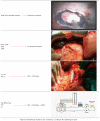Multimodal treatment of gastric cancer in the west: Where are we going?
- PMID: 26185368
- PMCID: PMC4499339
- DOI: 10.3748/wjg.v21.i26.7954
Multimodal treatment of gastric cancer in the west: Where are we going?
Abstract
The incidence of gastric cancer (GC) is decreasing worldwide, especially for intestinal histotype of the distal third of the stomach. On the contrary, proximal location and diffuse Lauren histotype have been reported to be generally stable over time. In the west, no clear improvement in long-term results was observed in clinical and population-based studies. Results of treatment in these neoplasms are strictly dependent on tumor stage. Adequate surgery and extended lymphadenectomy are associated with good long-term outcome in early-stage cancer; however, results are still unsatisfactory for advanced stages (III and IV), for which additional treatments could provide a survival benefit. This implies a tailored approach to GC. The aim of this review was to summarize the main multimodal treatment options in advanced resectable GC. Perioperative or postoperative treatments, including chemotherapy, chemoradiotherapy, targeted therapies, and hyperthermic intraperitoneal chemotherapy have been reviewed, and the main ongoing and completed trials have been analyzed. An original tailored multimodal approach to non-cardia GC has been also proposed.
Keywords: Chemotherapy; Epidemiology; Gastric cancer; Hyperthermic intraperitoneal chemotherapy; Radiotherapy; Targeted therapy.
Figures





References
-
- Ferlay J, Shin HR, Bray F, Forman D, Mathers C, Parkin DM. Estimates of worldwide burden of cancer in 2008: GLOBOCAN 2008. Int J Cancer. 2010;127:2893–2917. - PubMed
-
- La Vecchia C, Bosetti C, Lucchini F, Bertuccio P, Negri E, Boyle P, Levi F. Cancer mortality in Europe, 2000-2004, and an overview of trends since 1975. Ann Oncol. 2010;21:1323–1360. - PubMed
-
- Jemal A, Bray F, Center MM, Ferlay J, Ward E, Forman D. Global cancer statistics. CA Cancer J Clin. 2011;61:69–90. - PubMed
-
- Verlato G, Di Leo A, Maria Rossi G, de Manzoni G. Epidemiology of Gastric Cancer and Screening Programs. In: de Manzoni G, Roviello F, Siquini W., editors. Surgery in the multimodal management of gastric cancer. Milan: Springer; 2012. pp. pp. 1–7.
-
- Marrelli D, Pedrazzani C, Corso G, Neri A, Di Martino M, Pinto E, Roviello F. Different pathological features and prognosis in gastric cancer patients coming from high-risk and low-risk areas of Italy. Ann Surg. 2009;250:43–50. - PubMed
Publication types
MeSH terms
LinkOut - more resources
Full Text Sources
Other Literature Sources
Medical
Miscellaneous

